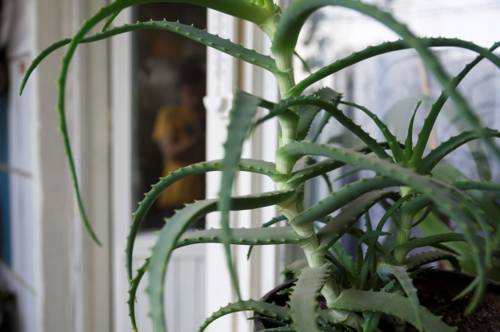
FAQ About Indoor Plant Stress Responses

What are common signs of stress in indoor plants?
Common signs of stress in indoor plants include yellowing or browning of leaves, leaf drop, wilting, stunted growth, and discoloration. You may also notice that the plant is not producing new growth as it normally would. These symptoms can indicate issues such as overwatering, underwatering, poor lighting, pests, or nutrient deficiencies.

How does overwatering stress indoor plants?
Overwatering is a common stressor for indoor plants because it suffocates the roots, depriving them of oxygen and leading to root rot. This can cause the plant's leaves to turn yellow and drop prematurely. Over time, the plant's growth slows down, and it can even die if the root rot becomes severe. To prevent this, it's crucial to allow the soil to dry out between waterings and ensure the pot has proper drainage.

What role does lighting play in indoor plant stress?
Lighting is a critical factor for indoor plant health. Insufficient light can lead to weak, spindly growth and may cause leaves to turn yellow and drop. On the other hand, too much direct sunlight can scorch the leaves, leading to browning and dehydration. Understanding the lighting needs of each plant species is crucial for minimizing stress and ensuring they thrive.

Can indoor plants recover from stress caused by pests?
Yes, indoor plants can recover from pest-related stress if addressed promptly. First, identify the type of pest and use appropriate treatments, such as neem oil or insecticidal soap, to eliminate them. Regularly inspect the plant for any signs of recurring pest activity and maintain good plant hygiene to prevent infestations. Providing optimal light, water, and nutrients will also help the plant regain its strength.

How does temperature affect indoor plant stress?
Temperature extremes can stress indoor plants significantly. Most houseplants thrive in temperatures between 60-75°F (15-24°C). Temperatures outside this range can impede growth, lead to wilting, or cause leaves to fall off. Sudden temperature changes, such as drafts from windows or heating vents, can also shock plants. Maintaining a consistent and suitable temperature range helps alleviate this stress.

What steps can be taken to reduce stress from nutrient deficiencies?
Nutrient deficiencies can be stressful for plants, leading to symptoms such as chlorosis (yellow leaves), poor growth, and fewer flowers. To reduce this stress, ensure a balanced fertilization regime tailored to the specific needs of your plant. Regularly check the plant's soil to ensure pH levels allow for proper nutrient absorption, and adjust if necessary.

How can repotting cause stress to indoor plants?
Repotting can stress indoor plants by disturbing their roots, especially if it's done improperly or too frequently. Symptoms may include wilting or dropping leaves. To minimize repotting stress, ensure that the new pot is just one size larger and provide similar soil conditions as before. Water the plant after repotting and avoid fertilizing immediately to give it time to acclimate.

Do humidity levels impact indoor plant stress?
Yes, humidity levels can affect indoor plant stress. Many indoor plants, especially tropical varieties, thrive in high humidity. Low humidity can cause leaves to brown and edges to crisp, while excessively high humidity can encourage mold and mildew. Maintaining an optimal humidity level through misting, using a humidifier, or grouping plants together can help mitigate stress.

What are some strategies to help indoor plants recover from stress?
To help indoor plants recover from stress, assess and correct the environmental factors causing distress, such as lighting, watering frequency, and humidity. Ensure the plant is free from pests or diseases and consider using a balanced fertilizer to promote recovery. Patience is key, as recovery can take time depending on the severity of the stress.

Why do indoor plant leaves curl, and is this a stress response?
Leaf curling in indoor plants is often a response to stress. Common causes include overwatering, underwatering, pest infestations, or environmental stress like low humidity. By identifying the precise cause, you can adjust care routines to mitigate this stress response, such as adjusting watering schedules or improving humidity and lighting conditions.

Can moving an indoor plant cause stress?
Yes, moving an indoor plant can cause stress due to changes in light, temperature, and humidity conditions. This stress might manifest as leaf drop or wilting. To minimize stress, gradually acclimate the plant to its new location over several days and make sure the new spot meets its specific environmental needs.

How does underwatering affect indoor plants?
Underwatering stresses indoor plants by depriving them of necessary moisture, leading to wilting and dry, crispy leaves. The soil may pull away from the pot edges, making water absorption harder. To alleviate this stress, water the plant thoroughly and consistently, ensuring soil absorbs the moisture evenly.

What is root rot, and how does it stress plants?
Root rot is a fungal disease that thrives in overly wet conditions, leading to decaying roots and impeding a plant's ability to absorb nutrients and water. Stressed plants show symptoms like yellowing leaves and stunted growth. Preventative measures include ensuring proper drainage and allowing the soil to dry between waterings.

Can pruning help reduce stress in indoor plants?
Pruning can indeed help reduce stress in indoor plants by removing dead or diseased parts, which can prevent the spread of pathogens and encourage healthier growth. It's essential, however, to use clean, sharp tools and to prune at the right time and in the correct way for each plant species to avoid additional stress.

Is it normal for indoor plants to drop leaves when under stress?
Yes, it is normal for indoor plants to drop leaves when stressed as a way to conserve resources. This can happen due to various stressors, such as changes in environment, pest infestations, or overwatering. Addressing the underlying cause can help the plant to stabilize and potentially grow new leaves.

How does transplant shock manifest in indoor plants?
Transplant shock may occur after repotting and is characterized by wilting, leaf discoloration, or drop. It happens when a plant struggles to adjust to new soil or potting conditions. Allowing time for acclimatization, minimizing root disturbance, and maintaining appropriate care routines can help reduce or prevent shock.

What environmental changes can cause stress to indoor plants?
Environmental changes such as variations in light exposure, temperature shifts, drafts, and changes in humidity levels can stress indoor plants. Sudden changes, especially, can lead to problems like wilting or leaf drop. Providing a stable and consistent environment helps plants adapt and reduces stress.

Are there indoor plant species more resistant to stress?
Yes, some indoor plant species are more adaptable and resilient to stress. For example, snake plants, pothos, and ZZ plants are known for their tolerance of varying light and watering conditions, making them ideal choices for less-than-perfect indoor environments.

How can I tell if my indoor plant is recovering from stress?
Signs of recovery in indoor plants include the emergence of new growth, such as shoots or leaves, and the stabilization of symptoms like wilting or discoloration. The plant may resume its normal growth rate and energy over time, indicating that it is adapting well to corrective measures taken.

What role does soil quality play in indoor plant stress?
Soil quality is integral to plant health. Poor soil can exacerbate stress by retaining too much water or failing to provide necessary nutrients. Ensuring well-draining soil with the right mix of nutrients helps maintain a healthy root environment, reducing potential stress factors for indoor plants.
